boot SKODA FABIA 2008 2.G / 5J User Guide
[x] Cancel search | Manufacturer: SKODA, Model Year: 2008, Model line: FABIA, Model: SKODA FABIA 2008 2.G / 5JPages: 252, PDF Size: 40.88 MB
Page 51 of 252
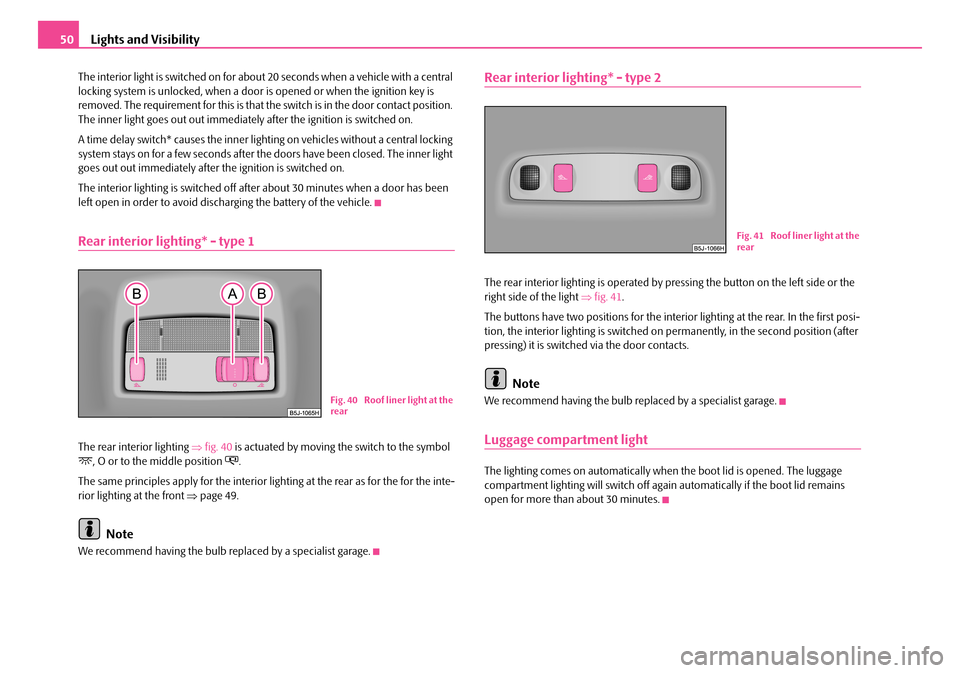
Lights and Visibility50
The interior light is switched on for about 20 seconds when a vehicle with a central locking system is unlocked, when a door is opened or when the ignition key is removed. The requirement for this is that the switch is in the door contact position. The inner light goes out out immediately after the ignition is switched on.
A time delay switch* causes the inner lighting on vehicles without a central locking system stays on for a few seconds after the doors have been closed. The inner light goes out out immediately after the ignition is switched on.
The interior lighting is switched off after about 30 minutes when a door has been left open in order to avoid discharging the battery of the vehicle.
Rear interior lighting* - type 1
The rear interior lighting ⇒fig. 40 is actuated by moving the switch to the symbol , O or to the middle position .
The same principles apply for the interior lighting at the rear as for the for the inte-rior lighting at the front ⇒page 49.
Note
We recommend having the bulb replaced by a specialist garage.
Rear interior lighting* - type 2
The rear interior lighting is operated by pressing the button on the left side or the right side of the light ⇒fig. 41.
The buttons have two positions for the interior lighting at the rear. In the first posi-tion, the interior lighting is switched on permanently, in the second position (after pressing) it is switched via the door contacts.
Note
We recommend having the bulb replaced by a specialist garage.
Luggage compartment light
The lighting comes on automatically when the boot lid is opened. The luggage compartment lighting will switch off again automatically if the boot lid remains open for more than about 30 minutes.
Fig. 40 Roof liner light at the rear
Fig. 41 Roof liner light at the rear
NKO A05F 20.book Page 50 Wednesday, April 2, 2008 1:02 PM
Page 63 of 252
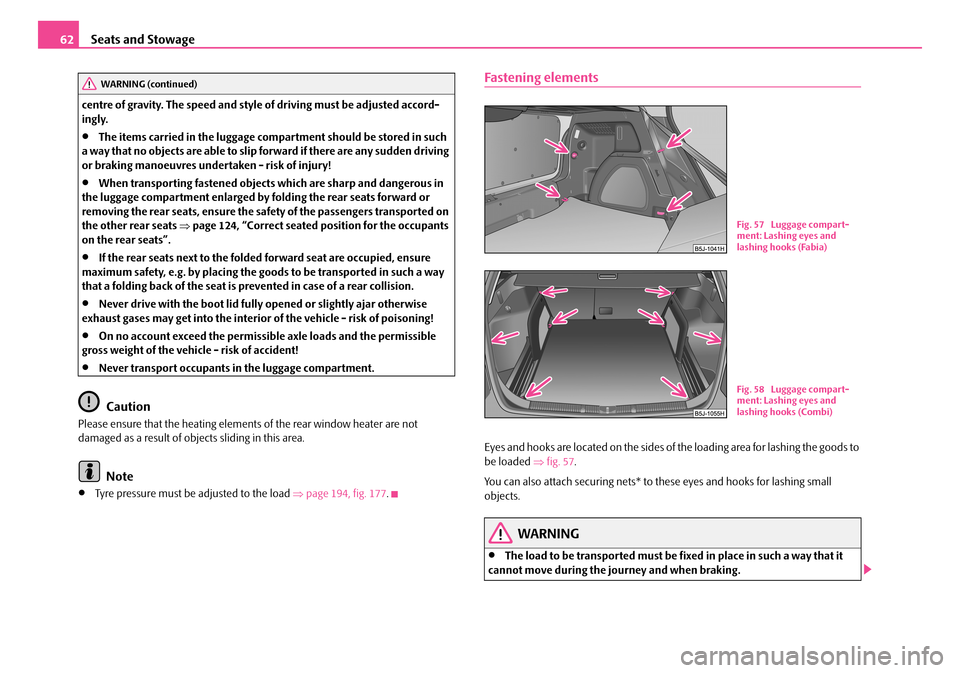
Seats and Stowage62
centre of gravity. The speed and style of driving must be adjusted accord-ingly.
•The items carried in the luggage compartment should be stored in such a way that no objects are able to slip forward if there are any sudden driving or braking manoeuvres undertaken - risk of injury!
•When transporting fastened objects which are sharp and dangerous in the luggage compartment enlarged by folding the rear seats forward or removing the rear seats, ensure the safety of the passengers transported on the other rear seats ⇒page 124, “Correct seated position for the occupants on the rear seats”.
•If the rear seats next to the folded forward seat are occupied, ensure maximum safety, e.g. by placing the goods to be transported in such a way that a folding back of the seat is prevented in case of a rear collision.
•Never drive with the boot lid fully opened or slightly ajar otherwise exhaust gases may get into the interior of the vehicle - risk of poisoning!
•On no account exceed the permissible axle loads and the permissible gross weight of the vehicle - risk of accident!
•Never transport occupants in the luggage compartment.
Caution
Please ensure that the heating elements of the rear window heater are not damaged as a result of objects sliding in this area.
Note
•Tyre pressure must be adjusted to the load ⇒page 194, fig. 177.
Fastening elements
Eyes and hooks are located on the sides of the loading area for lashing the goods to be loaded ⇒fig. 57.
You can also attach securing nets* to these eyes and hooks for lashing small objects.
WARNING
•The load to be transported must be fixed in place in such a way that it cannot move during the journey and when braking.
WARNING (continued)
Fig. 57 Luggage compart-ment: Lashing eyes and lashing hooks (Fabia)
Fig. 58 Luggage compart-ment: Lashing eyes and lashing hooks (Combi)
NKO A05F 20.book Page 62 Wednesday, April 2, 2008 1:02 PM
Page 65 of 252
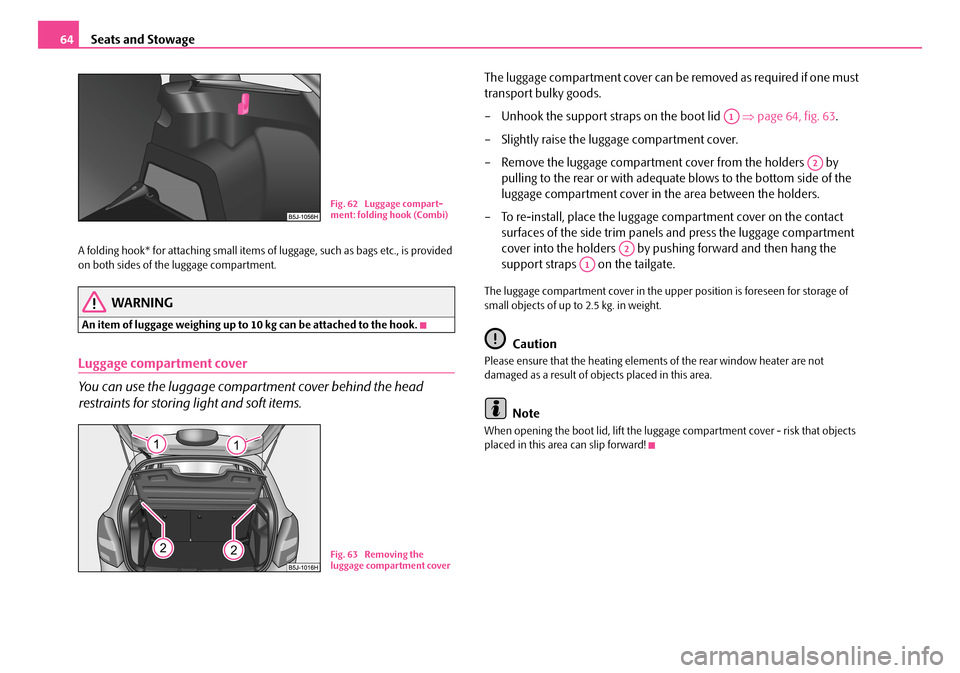
Seats and Stowage64
A folding hook* for attaching small items of luggage, such as bags etc., is provided on both sides of the luggage compartment.
WARNING
An item of luggage weighing up to 10 kg can be attached to the hook.
Luggage compartment cover
You can use the luggage compartment cover behind the head
restraints for storing light and soft items.
The luggage compartment cover can be removed as required if one must
transport bulky goods.
– Unhook the support straps on the boot lid ⇒page 64, fig. 63.
– Slightly raise the luggage compartment cover.
– Remove the luggage compartment cover from the holders by
pulling to the rear or with adequate blows to the bottom side of the
luggage compartment cover in the area between the holders.
– To re-install, place the luggage compartment cover on the contact
surfaces of the side trim panels and press the luggage compartment
cover into the holders by pushing forward and then hang the
support straps on the tailgate.
The luggage compartment cover in the upper position is foreseen for storage of small objects of up to 2.5 kg. in weight.
Caution
Please ensure that the heating elements of the rear window heater are not damaged as a result of objects placed in this area.
Note
When opening the boot lid, lift the luggage compartment cover - risk that objects placed in this area can slip forward!
Fig. 62 Luggage compart-ment: folding hook (Combi)
Fig. 63 Removing the luggage compartment cover
A1
A2
A2
A1
NKO A05F 20.book Page 64 Wednesday, April 2, 2008 1:02 PM
Page 66 of 252

Seats and Stowage65
Using the systemSafetyDriving TipsGeneral MaintenanceBreakdown assistanceTechnical Data
Further positions of the luggage compartment cover
You can use the luggage compartment cover behind the head
restraints for storing light and soft items.
The luggage compartment cover can also be put into the lower position on the supporting elements ⇒fig. 64.
The luggage compartment cover in the lower position is foreseen for storage of small objects of up to 6 kg. in weight.
The luggage compartment cover can also be stowed behind the rear seats ⇒fig. 65.
WARNING
No objects should be placed on the luggage compartment cover, the vehicle occupants could be endangered if there is sudden braking or the vehicle collides with something.
Caution
Please ensure that the heating elements of the rear window heater are not damaged as a result of objects placed in this area.
Note
When opening the boot lid, lift the luggage compartment cover - risk that objects placed in this area can slip forward!
Luggage compartment cover (Combi)
Fig. 64 Luggage compart-ment cover in the lower posi-tion
Fig. 65 Luggage compart-ment cover stowed behind the rear seats.
Fig. 66 Luggage compart-ment: The luggage compart-ment cover
NKO A05F 20.book Page 65 Wednesday, April 2, 2008 1:02 PM
Page 72 of 252
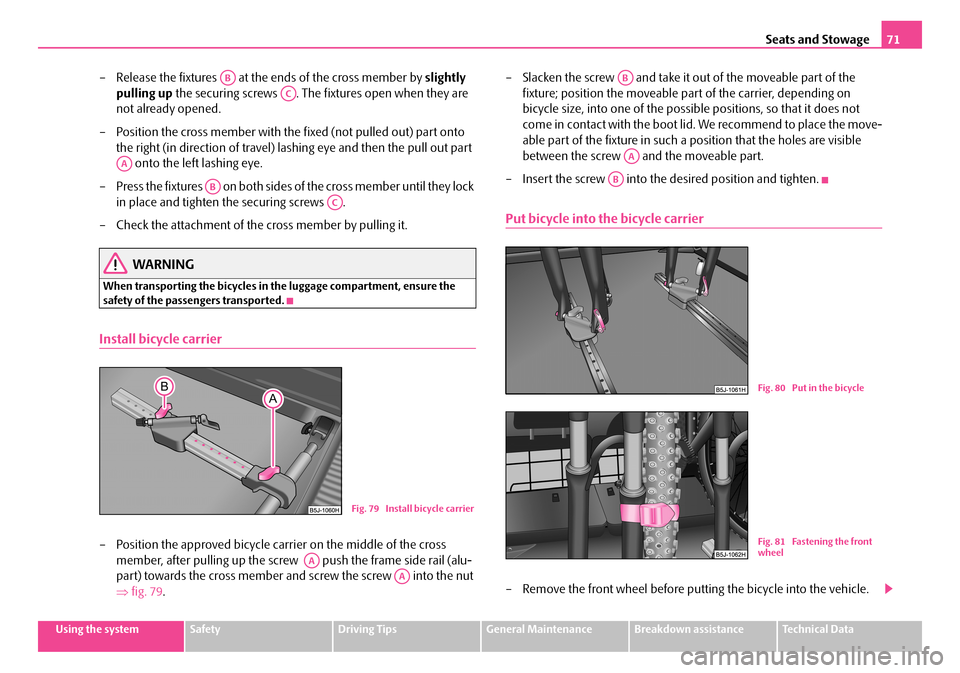
Seats and Stowage71
Using the systemSafetyDriving TipsGeneral MaintenanceBreakdown assistanceTechnical Data
– Release the fixtures at the ends of the cross member by slightly
pulling up the securing screws . The fixtures open when they are
not already opened.
– Position the cross member with the fixed (not pulled out) part onto
the right (in direction of travel) lashing eye and then the pull out part
onto the left lashing eye.
– Press the fixtures on both sides of the cross member until they lock
in place and tighten the securing screws .
– Check the attachment of the cross member by pulling it.
WARNING
When transporting the bicycles in the luggage compartment, ensure the safety of the passengers transported.
Install bicycle carrier
– Position the approved bicycle carrier on the middle of the cross
member, after pulling up the screw push the frame side rail (alu-
part) towards the cross member and screw the screw into the nut
⇒fig. 79.
– Slacken the screw and take it out of the moveable part of the
fixture; position the moveable part of the carrier, depending on
bicycle size, into one of the possible positions, so that it does not
come in contact with the boot lid. We recommend to place the move-
able part of the fixture in such a position that the holes are visible
between the screw and the moveable part.
– Insert the screw into the desired position and tighten.
Put bicycle into the bicycle carrier
– Remove the front wheel before putting the bicycle into the vehicle.
AB
AC
AA
AB
AC
Fig. 79 Install bicycle carrier
AA
AA
AB
AA
AB
Fig. 80 Put in the bicycle
Fig. 81 Fastening the front wheel
NKO A05F 20.book Page 71 Wednesday, April 2, 2008 1:02 PM
Page 73 of 252
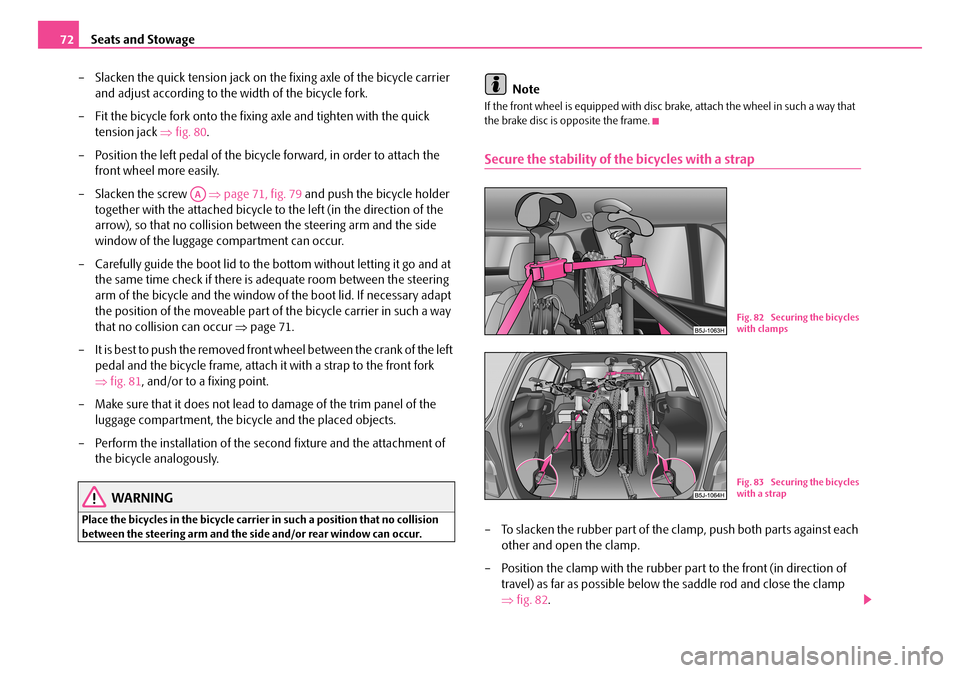
Seats and Stowage72
– Slacken the quick tension jack on the fixing axle of the bicycle carrier
and adjust according to the width of the bicycle fork.
– Fit the bicycle fork onto the fixing axle and tighten with the quick
tension jack ⇒fig. 80.
– Position the left pedal of the bicycle forward, in order to attach the
front wheel more easily.
– Slacken the screw ⇒page 71, fig. 79 and push the bicycle holder
together with the attached bicycle to the left (in the direction of the
arrow), so that no collision between the steering arm and the side
window of the luggage compartment can occur.
– Carefully guide the boot lid to the bottom without letting it go and at
the same time check if there is adequate room between the steering
arm of the bicycle and the window of the boot lid. If necessary adapt
the position of the moveable part of the bicycle carrier in such a way
that no collision can occur ⇒page 71.
– It is best to push the removed front wheel between the crank of the left
pedal and the bicycle frame, attach it with a strap to the front fork
⇒fig. 81, and/or to a fixing point.
– Make sure that it does not lead to damage of the trim panel of the
luggage compartment, the bicycle and the placed objects.
– Perform the installation of the second fixture and the attachment of
the bicycle analogously.
WARNING
Place the bicycles in the bicycle carrier in such a position that no collision between the steering arm and the side and/or rear window can occur.
Note
If the front wheel is equipped with disc brake, attach the wheel in such a way that the brake disc is opposite the frame.
Secure the stability of the bicycles with a strap
– To slacken the rubber part of the clamp, push both parts against each
other and open the clamp.
– Position the clamp with the rubber part to the front (in direction of
travel) as far as possible below the saddle rod and close the clamp
⇒fig. 82.
AA
Fig. 82 Securing the bicycles with clamps
Fig. 83 Securing the bicycles with a strap
NKO A05F 20.book Page 72 Wednesday, April 2, 2008 1:02 PM
Page 74 of 252
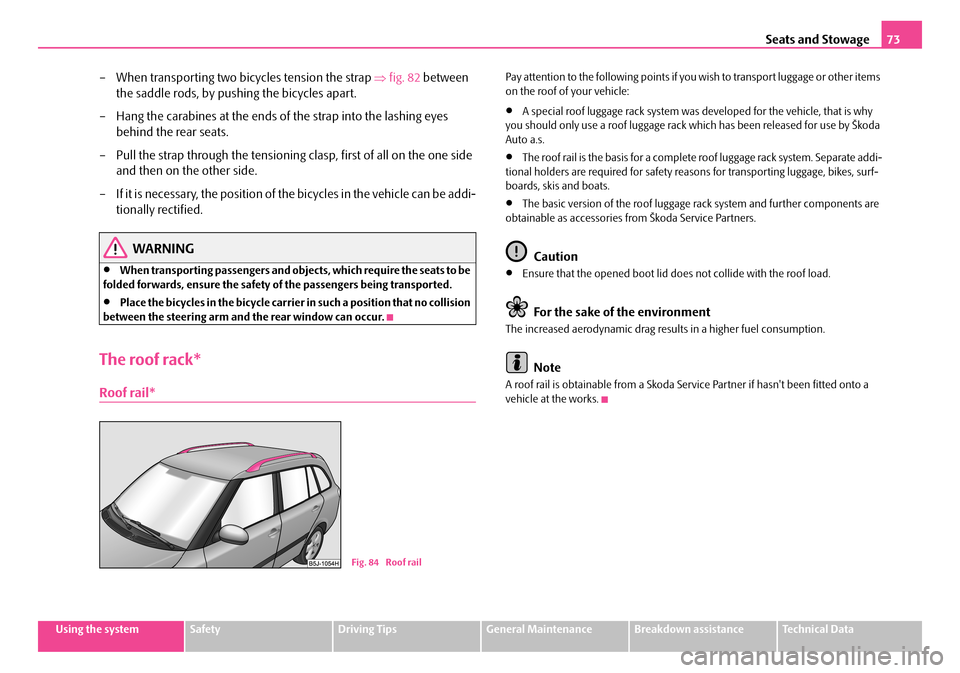
Seats and Stowage73
Using the systemSafetyDriving TipsGeneral MaintenanceBreakdown assistanceTechnical Data
– When transporting two bicycles tension the strap ⇒fig. 82 between
the saddle rods, by pushing the bicycles apart.
– Hang the carabines at the ends of the strap into the lashing eyes
behind the rear seats.
– Pull the strap through the tensioning clasp, first of all on the one side
and then on the other side.
– If it is necessary, the position of the bicycles in the vehicle can be addi-
tionally rectified.
WARNING
•When transporting passengers and objects, which require the seats to be folded forwards, ensure the safety of the passengers being transported.
•Place the bicycles in the bicycle carrier in such a position that no collision between the steering arm and the rear window can occur.
The roof rack*
Roof rail*
Pay attention to the following points if you wish to transport luggage or other items on the roof of your vehicle:
•A special roof luggage rack system was developed for the vehicle, that is why you should only use a roof luggage rack which has been released for use by Škoda Auto a.s.
•The roof rail is the basis for a complete roof luggage rack system. Separate addi-tional holders are required for safety reasons for transporting luggage, bikes, surf-boards, skis and boats.
•The basic version of the roof luggage rack system and further components are obtainable as accessories from Škoda Service Partners.
Caution
•Ensure that the opened boot lid does not collide with the roof load.
For the sake of the environment
The increased aerodynamic drag results in a higher fuel consumption.
Note
A roof rail is obtainable from a Skoda Service Partner if hasn't been fitted onto a vehicle at the works.
Fig. 84 Roof rail
NKO A05F 20.book Page 73 Wednesday, April 2, 2008 1:02 PM
Page 173 of 252
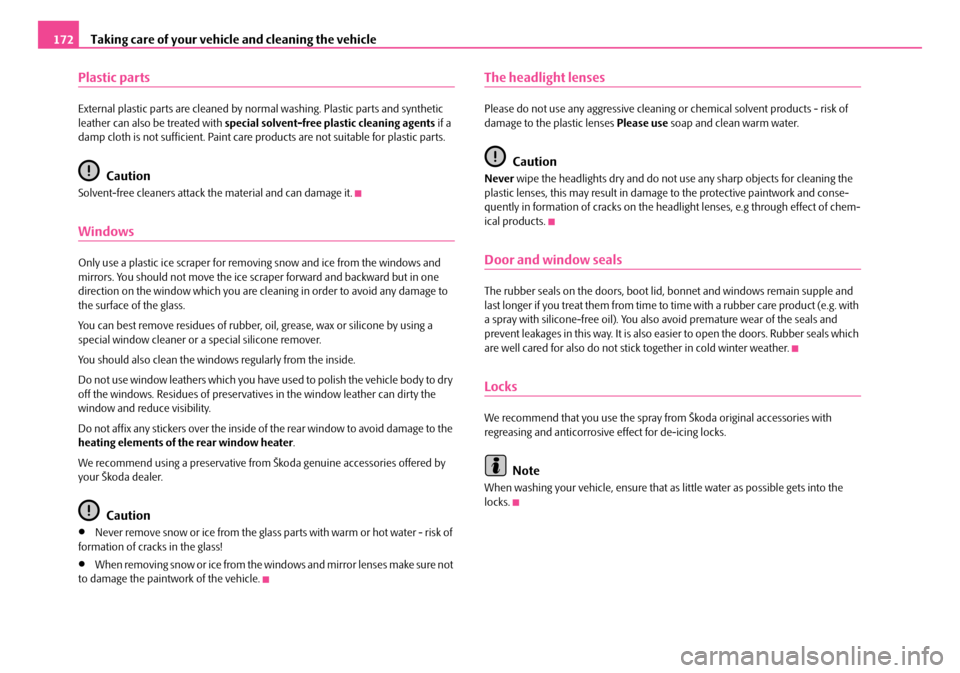
Taking care of your vehicle and cleaning the vehicle172
Plastic parts
External plastic parts are cleaned by normal washing. Plastic parts and synthetic leather can also be treated with special solvent-free plastic cleaning agents if a damp cloth is not sufficient. Paint care products are not suitable for plastic parts.
Caution
Solvent-free cleaners attack the material and can damage it.
Windows
Only use a plastic ice scraper for removing snow and ice from the windows and mirrors. You should not move the ice scraper forward and backward but in one direction on the window which you are cleaning in order to avoid any damage to the surface of the glass.
You can best remove residues of rubber, oil, grease, wax or silicone by using a special window cleaner or a special silicone remover.
You should also clean the windows regularly from the inside.
Do not use window leathers which you have used to polish the vehicle body to dry off the windows. Residues of preservatives in the window leather can dirty the window and reduce visibility.
Do not affix any stickers over the inside of the rear window to avoid damage to the heating elements of the rear window heater.
We recommend using a preservative from Škoda genuine accessories offered by your Škoda dealer.
Caution
•Never remove snow or ice from the glass parts with warm or hot water - risk of formation of cracks in the glass!
•When removing snow or ice from the windows and mirror lenses make sure not to damage the paintwork of the vehicle.
The headlight lenses
Please do not use any aggressive cleaning or chemical solvent products - risk of damage to the plastic lenses Please use soap and clean warm water.
Caution
Never wipe the headlights dry and do not use any sharp objects for cleaning the plastic lenses, this may result in damage to the protective paintwork and conse-quently in formation of cracks on the headlight lenses, e.g through effect of chem-ical products.
Door and window seals
The rubber seals on the doors, boot lid, bonnet and windows remain supple and last longer if you treat them from time to time with a rubber care product (e.g. with a spray with silicone-free oil). You also avoid premature wear of the seals and prevent leakages in this way. It is also easier to open the doors. Rubber seals which are well cared for also do not stick together in cold winter weather.
Locks
We recommend that you use the spray from Škoda original accessories with regreasing and anticorrosive effect for de-icing locks.
Note
When washing your vehicle, ensure that as little water as possible gets into the locks.
NKO A05F 20.book Page 172 Wednesday, April 2, 2008 1:02 PM
Page 222 of 252

Fuses and light bulbs221
Using the systemSafetyDriving TipsGeneral MaintenanceBreakdown assistanceTechnical Data
Licence plate light
– Open the boot lid and unscrew the light glass.
– Take the faulty bulb out of the fixture and insert a new one.
– Re-insert the light glass. Press the light glass in up to the stop - check
for correct seating of the sealing rubber.
– Screw on the light glass but not too tightly.
Rear light unit
– Open the boot lid/luggage compartment door.
– Hold tight the rear light unit with one hand and unscrew the plastic nut
with the other hand ⇒fig. 205.
– Grip the rear light unit and remove it carefully with loosening move-
ments at an angle to the rear. Do not pull the grommet with the cables
out of the body.
– Replace the defective light bulb ⇒page 222.
– When re-installing, first insert the rear light unit with the screw into
the opening of the body ⇒fig. 206.
– Carefully press the rear light unit into the body in such a way that the
pins engage into the supports of the body.
– Hold the rear light unit tight with one hand, screw on the plastic nut
with the other hand and tighten it ⇒fig. 205.
Caution
When removing and installing the rear light unit make sure not to damage the paintwork of the vehicle and the rear light unit.
Fig. 204 Remove the licence plate light
Fig. 205 Remove the rear light unit
Fig. 206 Install the rear light unit
A
A
NKO A05F 20.book Page 221 Wednesday, April 2, 2008 1:02 PM
2
1
Page 223 of 252
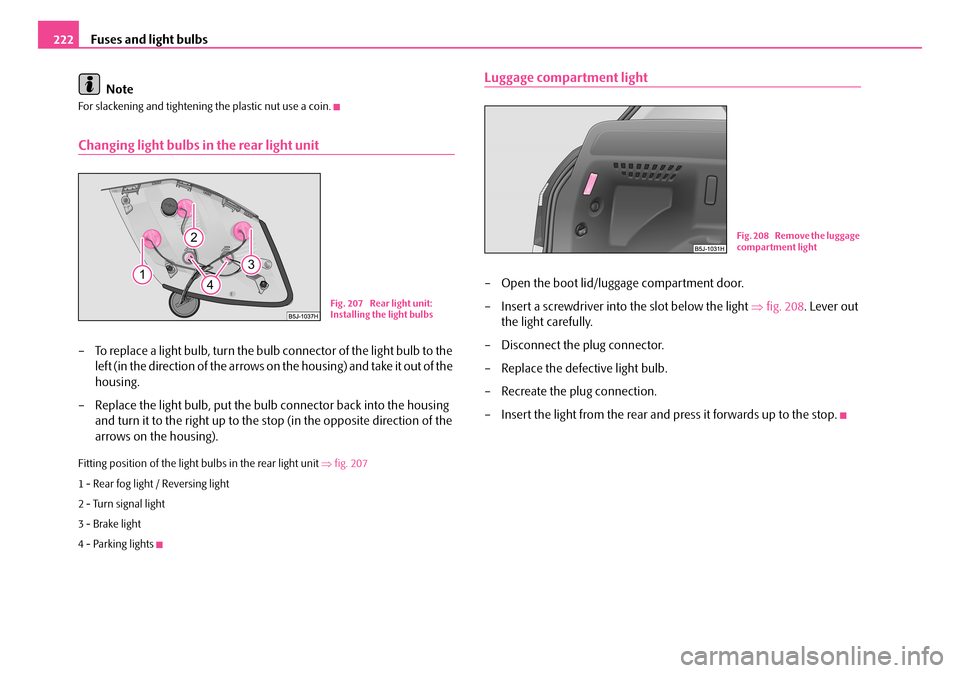
Fuses and light bulbs222
Note
For slackening and tightening the plastic nut use a coin.
Changing light bulbs in the rear light unit
– To replace a light bulb, turn the bulb connector of the light bulb to the
left (in the direction of the arrows on the housing) and take it out of the
housing.
– Replace the light bulb, put the bulb connector back into the housing
and turn it to the right up to the stop (in the opposite direction of the
arrows on the housing).
Fitting position of the light bulbs in the rear light unit ⇒fig. 207
1 - Rear fog light / Reversing light
2 - Turn signal light
3 - Brake light
4 - Parking lights
Luggage compartment light
– Open the boot lid/luggage compartment door.
– Insert a screwdriver into the slot below the light ⇒fig. 208. Lever out
the light carefully.
– Disconnect the plug connector.
– Replace the defective light bulb.
– Recreate the plug connection.
– Insert the light from the rear and press it forwards up to the stop.
Fig. 207 Rear light unit: Installing the light bulbs
Fig. 208 Remove the luggage compartment light
NKO A05F 20.book Page 222 Wednesday, April 2, 2008 1:02 PM